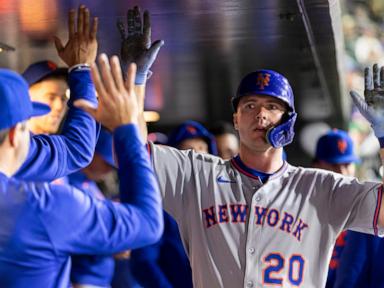When Griffin Canning was traded from the Angels to the Braves this past Halloween, there was immediate conversation on Baseball Twitter about whether the Braves would "fix" Canning and turn him into the 2025 version of Reynaldo Lopez. With Canning off to a strong start to begin the 2025 season, it appears there was reason to be optimistic about the 29-year-old; only, he may have found his answers in New York instead of Atlanta.
Less than a month after trading for Canning, the Braves didn't tender him a contract, satisfied in simply saving money by trading Jorge Soler for Canning weeks earlier. That allowed the Mets to swoop in and sign Canning to a one-year, $4.25 million deal. It's a move that has worked wonders for both sides.
"I love it here," smiled Canning earlier this week. "I'm really enjoying my time. Everything is top of the line. I'm enjoying the change in scenery and just kind of experiencing something new."
Canning has spent every season of his professional career with the Los Angeles Angels after being a second-round pick in the 2017 MLB Draft. Canning was also born in Mission Viejo, California, and spent three seasons pitching in college for UCLA, so shipping off to New York may be the biggest change of scenery he's had in his baseball career.
You can't blame him for choosing the Mets either. Since the regime change in New York two seasons ago, the Mets have begun building a reputation as a pitcher-friendly organization that creates smart plans to maximize the skills of their pitchers. Just last season, the Mets coached Luis Severino to a 3.91 ERA, 1.24 WHIP, and 21.2% strikeout rate after a season with the Yankees where he seemed totally lost and registered a 6.65 ERA and 19% strikeout rate. They also changed Sean Manea's arm slot and pitch mix to help drive him to a 3.47 ERA and 1.08 WHIP in 181.2 innings, the best season of his career.
Perhaps Canning can be next. After breaking out with a 3.65 ERA and 26.3% strikeout rate in the minors in 2018, and then producing a 3.99 ERA and 23.5% strikeout rate with the Angels in 2020, Canning's progress has halted. Injuries have certainly played a part, as he dealt with elbow irritation last year, a groin strain in 2023, and a lower back stress fracture in 2021 that sidelined him for the whole 2022 season.
The 29-year-old is healthy now and looking for something new. Part of that openness to something new has been changing his approach to pitch backwards, using breaking balls as the foundation of his pitch mix instead of fastballs.
"The conversation this spring was just kind of like, 'Hey, these are your best pitches. Why not lean on these?'" remembered Canning.
It's a simple concept, but one that has worked for many pitchers before and could be working for Canning as well. Heading into his start on Saturday against the Athletics, Canning has allowed three runs on eight hits in 9.2 innings over his first two starts while striking out 10 and walking five. It's not a perfect start, but his swinging strike rate is up, his CSW is the highest it's ever been, and his hard contact allowed is down.
It's too early in the season to call anything a breakout, but the added emphasis on using his best pitches more could have been the simple tweak that Canning needed to build on the promise he has tantalized with. Throughout his five-year MLB career, the best pitch for Canning has always been his slider. Since the 2021 season, he has never used it less than 24% of the time in a season, and it has never posted a swinging strike rate (SwStr%) below 16.7%. For comparison sake, the MLB average SwStr% for starting pitcher sliders is 15.3%, so Canning has always been able to miss bats ...


